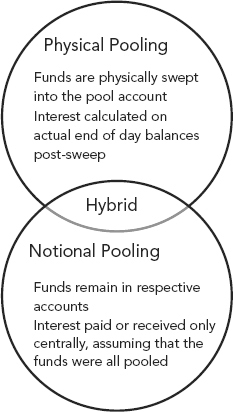Chapter Nine
Cash Pooling and Efficiency
ONE OF THE TOPICS OF MOST discussion in recent financial and corporate times is the pooling of cash and the processes that make the availability of cash and its use a lot tighter. The liquidity events of 2008 highlighted the use of cash, as we will see in Part Three of this book. In this chapter, we focus on the cash concentration aspects of transactions management, looking at the implementation of various structures that would help to pool cash in together.
CASH CONCENTRATION STRUCTURES
The ability to concentrate cash into one location and preferably in one currency has been a challenge for Treasurers ever since company operations became physically dispersed. Concentration structures can be one of two broad methods—notional pooling and physical pooling—or combinations of these (see Figure 9.1).
FIGURE 9.1 Concentration Structure Types

Physical Pooling
Physical pooling is the simplest method to appreciate: Cash is moved from one account to the other through a physical transfer and then moved back in the morning if required. The actual transfer happens to a master “concentration” account, and the net position is managed centrally.
Physical pooling can be:
- Cross-border
- Cross-regional
- Cross-bank
- Zero balance in each of the pooling accounts, or a targeted minimum balance
The more automated the environment is, the easier it is to achieve efficiencies ...
Get The Handbook of Global Corporate Treasury now with the O’Reilly learning platform.
O’Reilly members experience books, live events, courses curated by job role, and more from O’Reilly and nearly 200 top publishers.

